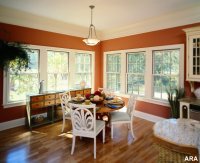 (ARA) – What will the lighting in your home look like in the future? Monty Gilbertson, a certified lighting consultant (CLC) and manager of Lighting Designs by Wettsteins in La Crosse, Wis., is predicting it will look at lot like it does today, only it will be more energy efficient.
(ARA) – What will the lighting in your home look like in the future? Monty Gilbertson, a certified lighting consultant (CLC) and manager of Lighting Designs by Wettsteins in La Crosse, Wis., is predicting it will look at lot like it does today, only it will be more energy efficient.
As a member of the Lighting Vision Committee for the non-profit Consortium for Energy Efficiency in Boston, he is among those charged with coming up with ways to get the general public to use 50 percent less lighting energy by 2012. The ideas they have come up with so far include educating the public about the benefits of using more energy efficient compact florescent bulbs, moving to Energy Star-qualified fixtures and using dimmers with the new technologies.
Norm Brown, regional manager of Noburn Lighting and Bath Center in Vancouver, B.C., says the latter is among the most promising recommendations he has heard. ‘Not only do you get great aesthetic results from putting lights on dimmers, the energy savings are astounding,’ he says. ‘You use less wattage and double the life of the bulb to boot.’
‘In addition, dimmers allow for greater flexibility in lighting product selection and allow you to get multiple uses out of a room,’ adds Gilbertson.
In today’s homes, the three main types of lighting available are incandescent, magnetic low voltage and electronic low voltage which are all easily dimmed, and there are several different types of dimmers. They include:
- Simple wall box dimmers, which allow you to bring the light up and down slowly;
- Scene lighting dimmers, which allow you to control multiple light sources from a single panel to set a mood;
- Whole house systems, which allow you to control all of the lights in your home from one panel at the touch of a button; and
- Occupancy sensors, which come on and off whenever someone enters a room.
Chad Coyne, national sales manager for lighting showrooms at the Leviton Manufacturing Company, based in Littleneck, N.Y., expects occupancy sensors to get a lot of attention in the coming months, especially now that President Bush has signed the Energy Independence and Security Act into law.
‘We’re trying to educate people to use these in dressing rooms, laundry rooms, closets and other spaces they move in and out of frequently but don’t stay in too long,’ he says. ‘They offer great energy savings.’
Karen Engle, CLC of Zanger Associates Inc., of Eldersburg, Md., points out dimmers of all types are extremely useful, particularly for those who like to entertain often. ‘I recommend people put dimmers just about everywhere in the house because they offer such great flexibility,’ she says. ‘For example, when everyone’s gathering for a party, it’s nice to have the lights at full brightness; but as your guests move into the house and get comfortable, low light is more desirable. Then later when it’s time to clean up, it’s nice to be able to bring the lights to full strength again at the flip of a switch,’ says Engle.
Jacklyn Stanton, owner of lighting supplier Lytestyles in Knoxville, Tenn., says ‘Technology is moving forward so quickly, I predict that within ten years, you won’t even be able to find today’s darling, the fluorescent bulb, on store shelves anymore, much less Thomas Edison’s incandescent light bulb. Everyone will be using LEDs, which by the way are already dimmable.’
Will that be the case? We’ll just have to wait and see.
For more information about lighting design, or to find a lighting showroom near you, log on to the American Lighting Association’s Web site at www.americanlightingassoc.com or call 800-BRIGHT-IDEAS (800-274-4484).
Courtesy of ARAcontent
